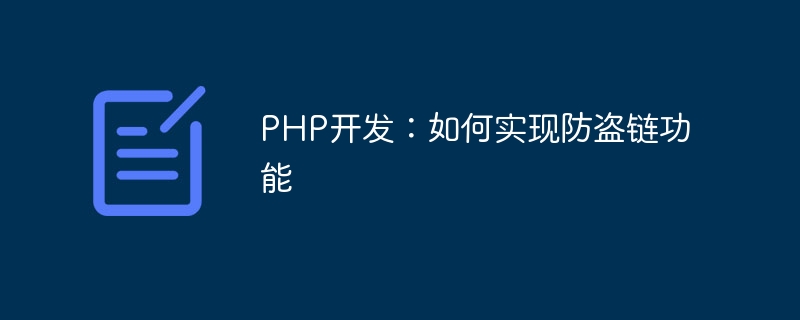

PHP development: How to implement the anti-hotlink function requires specific code examples
With the rapid development of the Internet, the anti-hotlink function has become important for website protection of resources and security One of the means. Through anti-hotlinking, websites can avoid illegal theft of resources or malicious links, improve access speed and save bandwidth consumption. This article will introduce how to use PHP language to implement the anti-hotlinking function and provide specific code examples.
The principle of anti-leeching is to determine whether the request comes from a specified legal site by checking the HTTP Referer field in the request. If the Referer field of the request is empty or does not match the specified legal site, corresponding processing will be performed, such as returning a custom error page or directly rejecting the request. The following is a code example to implement legal site judgment:
<?php
// 定义合法站点列表
$legal_sites = array(
'https://www.example1.com',
'https://www.example2.com'
);
// 获取请求中的Referer字段
$referer = $_SERVER['HTTP_REFERER'];
// 判断Referer是否为空
if(empty($referer)){
// Referer字段为空,进行处理,例如返回错误页面
header('Location: error.php');
exit;
}
// 判断Referer是否与合法站点匹配
$is_legal = false;
foreach($legal_sites as $site){
if(strpos($referer, $site) !== false){
$is_legal = true;
break;
}
}
// 判断是否为合法请求
if(!$is_legal){
// 请求不合法,进行处理,例如返回错误页面
header('Location: error.php');
exit;
}
// 合法请求,进行相关操作
// ...
?>In the above code, we first define a $legal_sites array, which contains a list of legal sites that are allowed to access resources. Then get the Referer field in the request through $_SERVER['HTTP_REFERER']. Next, we loop through the list of legal sites and use the strpos function to determine whether the Referer field matches the legal site. If the match is successful, set $is_legal to true, indicating that the request is a legal request. Finally, perform corresponding processing according to the value of $is_legal, such as returning an error page or performing other operations.
In addition to the above simple implementation, we can also perform more complex anti-leeching functions. For example, on the basis of checking the Referer field, more secure verification methods such as verification code and user verification can be added. In addition, in order to prevent hotlinkers from bypassing inspections by forging the Referer field, we can also use other more advanced anti-hotlinking technologies, such as using Token verification, dynamically generating access links, etc. Based on specific needs, we can choose a suitable anti-hotlink solution.
In summary, it is a relatively simple and effective method to implement the anti-leeching function through PHP language. We can check whether the request comes from a legitimate site by checking the Referer field in the request, and handle it accordingly based on the judgment result. In practical applications, according to needs, security verification methods and protection strategies can be further added to improve the anti-leeching effect and security.
Note: The above is a pseudocode example, and the specific implementation may vary depending on the actual situation.
The above is the detailed content of PHP development: How to implement anti-hotlinking function. For more information, please follow other related articles on the PHP Chinese website!